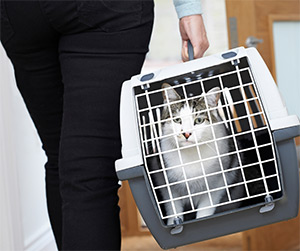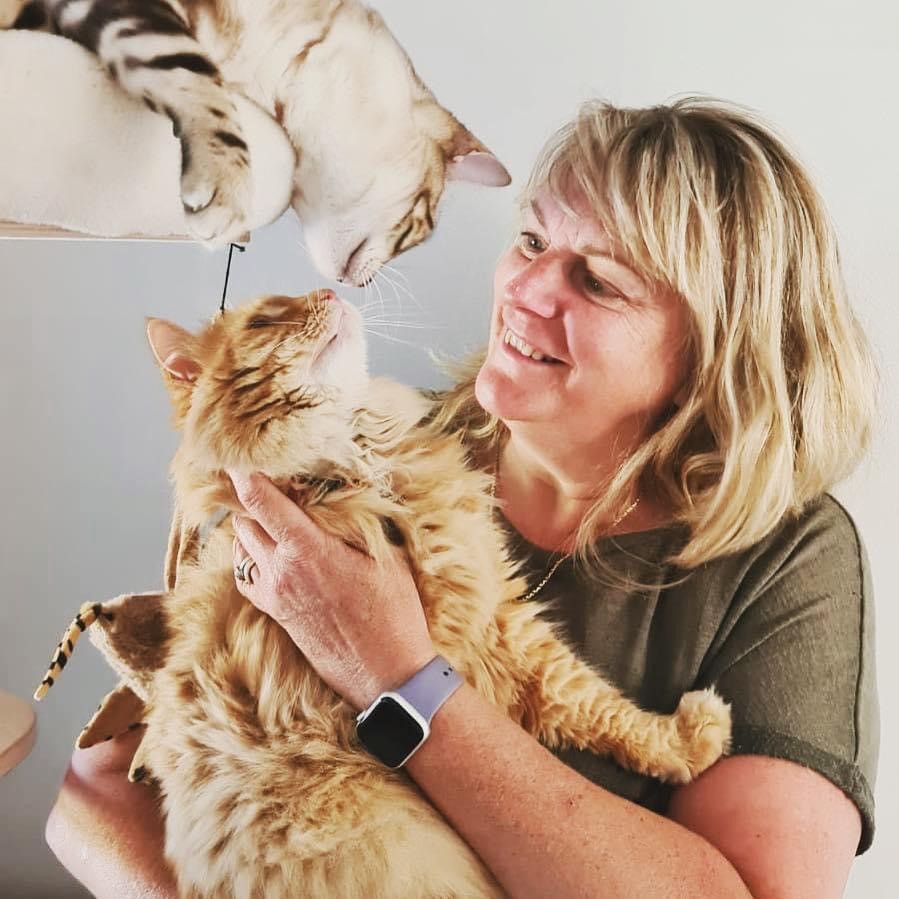Travelling with Your Cat:
How Synthetic Pheromones Can Help Reduce Stress
Travelling with your cat is an unavoidable part of life for many cat parents. Whether it is a routine vet visit, a trip to a boarding cattery, or even using public transport, these experiences can be highly stressful and triggering for cats. Unlike dogs, which may enjoy car rides and new environments, cats thrive on the predictability of their routine and territorial stability; thus, this makes travelling with them a very challenging experience. It is stressful for the human caregiver as well as the cat. As a clinical cat behaviourist, I have some tips to ease feline anxiety and make travel as stress-free as possible.

Why Travel Is Stressful for Cats?
Cats are territorial animals, and any environmental change can cause them acute anxiety. Often, just seeing the cat carrier can cause your cat to shake and hide in anticipation of what is to come. This can be due to several reasons: Unfamiliar scents and surroundings and removing your cat from its known territory can trigger fear and insecurity.
Loud noises and motion: The sounds of a car engine, public transport, or even the movement of a carrier can be unsettling. Being contained removes their autonomy and inhibits their flight instinct when under stress.
Separation from their safe space. Even temporarily, being away from their familiar home environment can cause stress-related behaviors like excessive meowing, defecation, urination, drooling, or hiding under a blanket in the carrier. Learned behaviour from a previous stressful trip in their carrier. Cats don’t forget these previous experiences that caused them to react to the containment and subsequent experience, whether at the vet or boarding cattery, which are stressful experiences for a cat.
How Comfort Zone Synthetic Pheromones Can Help
Comfort Zone products mimic the natural facial pheromones cats use to mark safe territory, helping them feel secure in new or stressful environments. Here are some ways that different Comfort Zone cat calming products can support your cat while travelling:
1. Comfort Zone Collar:Continuous Pheromone Support
The Comfort Zone Calming Collar constantly releases synthetic feline facial pheromones, helping your cat feel more relaxed during travel. For longer trips, consistent exposure to calming pheromones is beneficial.
If your cat is not used to wearing a collar, place it inside their carrier to provide a comforting scent.
2. Comfort Zone Diffuser: Pre-Travel Preparation
Using a Comfort Zone Diffuser in your home a few days before a trip can help create a calm environment and reduce pre-travel anxiety. If you are leaving your cat at a boarding cattery, consider giving them a blanket or bedding from home that has been in a Comfort Zone environment. Training your cat well ahead of any journey over the weeks that precede the trip to see the carrier itself as a safe space can reduce the stress by half. You can do this by leaving the carrier in the environment, placing familiar blankets, giving treats, and leaving your favourite toys inside. The cat will start associating the carrier with a sense of normality in their home environment.
Travel Scenarios and How to Reduce Stress with Comfort Zone
1. Visiting the Vet: Reducing Stress Before, During, and After
Many cats become anxious at the vet due to unfamiliar smells and past negative experiences.
To ease the process:
For a few days before travel, use a Comfort Zone calming diffuser and a familiar blanket and the carrier near to the diffuser.
During transport:
Use a Comfort Zone calming collar either on your cat or simply place it inside the carrier for added comfort. At the vet’s clinic, keep your cat in the carrier, ideally raised off the floor and covered with a towel, until inside the consultation room to minimize exposure to stress-inducing scents and sounds. Many vets hold an award from the International Society of Feline Medicine (ISFM), which means they have separate cat waiting areas and provide elevated places to rest your carrier on, along with towels and a cat-calming spray.
2. Going to a Boarding Cattery: Ensuring a Smooth Transition
Boarding catteries can be stressful due to new surroundings and the presence of other cats.
To help your cat adjust:
Before the trip, use a Comfort Zone Diffuser at home to establish a calm environment before departure. Nutraceuticals can be given to your cat up to two weeks before and during the stay in the cattery. These are amino acids that work similarly to an antidepressant (SSRI) and regulate the happy hormone serotonin in the cat’s brain just to help the cat feel a little bit calmer in a stressful situation.
During transport:
Use a comfort zone collar inside the carrier and bring a familiar-scented blanket. At the cattery, ask if you can leave an item from home, like a small bed, blanket, or t-shirt that you have slept in for several nights; that will be a reassuring scent for your cat. You can even bag some more of these in a zip-lock bag that can be rotated during the stay so a more pungent smell of the home is available with each new use.
3. Using Public Transport: Navigating Stressful Travel Situations
Public transport can be particularly distressing due to noise, movement, and unfamiliar people. To make the journey smoother:
Carrier Preparation:
Use a Comfort Zone calming collar inside the carrier before travel.
Minimise Movement:
To reduce excessive shaking, keep the carrier on a stable surface (e.g., your lap) and place a towel or thick blanket inside so your cat can grip its claws and feel slightly more secure.
Cover the Carrier:
Shades are not just for parrots! Placing a light blanket over the carrier can help block out stressful visual stimuli while still allowing airflow.
Avoid peak hours when traveling on buses or trains during quieter times to reduce exposure to noise and crowds. If this is not possible, consider taking a taxi or even a friend to help you make the journey.
Scholarly References for Further Reading
1. Mills, D. S., Karagiannis, C. I., & Zulch, H. (2014). Stress and Pheromonatherapy in the Separation of Cats and Dogs Journal of Veterinary Behavior, 9(6), 370-377. This study reviews how synthetic pheromones can reduce cat stress during travel and environmental changes.
2. DePorter, T. L., & Landsberg, G. M. (2016). Behavioral pharmacology and pheromone therapy for the management of feline anxiety Veterinary Clinics of North America: Small Animal Practice, 46(5), 877-888. Discusses how synthetic pheromones can be used as part of a multimodal approach to reduce cat stress-related behaviors.
3. Frank, D., Beauchamp, G., & Palestrini, C. (2010). Systematic review of the use of pheromones for the management of feline stress and anxiety Journal of the American Veterinary Medical Association, 236(12), 1308-1316. This systematic review evaluates the effectiveness of pheromone therapy for cats, including applications for travel-related stress.
Final Thoughts:
A Stress-Free Journey for Your Cat Travelling with a cat doesn’t have to be a stressful experience. Incorporating cat attractants and calming synthetic pheromone products into your travel routine can create a more calming environment and help your cat feel secure, whether they are heading to the vet, boarding cattery, or navigating public transport. With the proper preparation and pheromone support, you can ensure a smoother, less stressful journey for you and your cat companion

Amanda Campion
Clinical Feline Behaviourist CAB APBC ABTC

